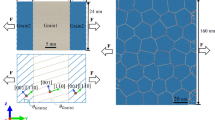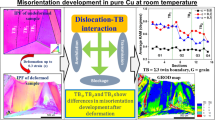Abstract
Plastic deformation is known to be highly orientation sensitive. This orientation sensitivity of deformation gets further accentuated in case of hexagonal materials. Present study is an attempt to bring out the role of crystal orientation on the dislocation nucleation behavior of Zr (hcp material). Molecular dynamics simulations have been performed on single-crystal Zr with different orientations covering entire fundamental zone of orientations. Simulations have brought out high degree of orientation sensitiveness in dislocation nucleation stresses and considerable asymmetry of critical stresses of homogenous nucleation of dislocation in tension and compression. It was shown that it is easier to nucleate < a > type dislocations than < c > type. This is in agreement with the experimental observation of higher density of < a > type dislocations in comparison to < c > type in Zr. While a majority of the orientations have resulted in the formation of dislocations, certain orientations have resulted in the homogenous nucleation of nanotwins during the deformation. The simulations indicated, consistent with experimental evidence, larger density of < a > type dislocations in prismatic planes in comparison to the basal planes of Zr and dominance of prismatic slip in the deformation behavior of Zr.









Similar content being viewed by others
References
Hirth JP, Lothe J, Theory of Dislocations. John Wiley and Sons, Inc. (1982).
Ma, F. Roters, D. Raabe, Acta Mater 54 (2006) 2169-2179.
Tschopp M A, Spearot D E, and McDowell D L, Model Simul Mater Sci Eng 15 (2007) 693–709.
Techopp M A., McDowell D L, J. Mech Phy Solids 56 (2008) 1806-1830.
Van Swygenhoven H , Derlet P, and Frø seth A, Acta Mater 54 (2006) 1975.
Liu Y, Van der Giessen E, and Needleman A, Int J Solids Struct44 (2007) 1719.
Tenckhoff E, J ASTM Int 2 (2005) 12945.
Murty KL, Charit I, Prog Nucl Energy 48 (2006) 325–359.
Verlinden B, Driver J, and Samajdar I , Doherty RR., Thermo Mechanical Processing of Metallic Materials. Elsevier Ltd, 1st ed., (2007).
Akhtar A, Acta Met21 (1973) 1
Akhtar A, J Nucl Mater 47 (1973) 79.
Akhtar A, Met Trans A 6 (1975) 1217.
Beyerlein I J, Tome C N Int J Plast 24 (2008) 867
Plimpton S, J Comp Phy 117 (1995) 1.
Daw M S, Foiles M S, and Baskes M I, Mater Sci Rep 9 (1993) 251.
Mendelev M I, Ackland G J,Philos Mag Lett 87 (2007) 349.
Voskoboinikov R, Osetsky Y, and Bacon D, Mater Sci Eng A 400–401 (2005) 45.
Stukowski A, Albe K Modell Simu Mater Sci Engg 18 (2010) 25016.
Dai C, Saidi P, Béland LK, Yao Z, Daymond MR Comput Mater Sci170 (2019) 109183.
Author information
Authors and Affiliations
Corresponding author
Additional information
Publisher's Note
Springer Nature remains neutral with regard to jurisdictional claims in published maps and institutional affiliations.
Rights and permissions
About this article
Cite this article
Krishna, K.V. Role of Crystal Orientation on Dislocation Nucleation in Zr: A Molecular Dynamics Study. Trans Indian Inst Met 75, 1083–1092 (2022). https://doi.org/10.1007/s12666-022-02560-2
Received:
Accepted:
Published:
Issue Date:
DOI: https://doi.org/10.1007/s12666-022-02560-2




